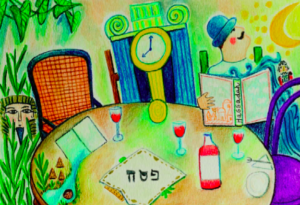A colorful Haggadah answers your questions
 Chag hamatzot (feast of unleavened bread), zeman cherutenu (feast of freedom), chag aviv (feast of spring). These are the names by which Pesach is known, but what is the difference between these meanings? An answer can be found in the new edition of the Haggadah of Pesach by the publisher Belforte, characterized by a stimulating dialogue on the many themes that this holiday has posed to Judaism for millennia.
Chag hamatzot (feast of unleavened bread), zeman cherutenu (feast of freedom), chag aviv (feast of spring). These are the names by which Pesach is known, but what is the difference between these meanings? An answer can be found in the new edition of the Haggadah of Pesach by the publisher Belforte, characterized by a stimulating dialogue on the many themes that this holiday has posed to Judaism for millennia.
The role of the interviewer is played by Dario Coen, who asks some specific questions to the Rabbi Roberto Della Rocca and the psychoanalyst Alberto Sonnino. The volume, whose introduction is signed by the rav Riccardo Di Segni, is enhanced by the colorful illustrations by Micol Nacamulli.
“In the Torah – explains Rabbi Della Rocca – the name Pesach is mainly linked to the qorbàn, sacrifice (Shemòt, 12; 11), and is instead chag ha matzòt, the feast of unleavened bread (Shemòt, 23; 15), an expression that better defines this holiday, since its symbol is the matza. The matzot are also the paradigm of freedom, symbolized by the genuineness and ‘diligence’ with which this bread must be kneaded”.
Another question concerns the figure of the “wise man”, one of the protagonists of the two evenings of the Seder. If he already knows everything, why does he need to ask questions? Where does this need come from? “Asking – Sonnino recalls – means seeking, questioning, orienting oneself to new discoveries, in order to acquire more knowledge, feeling not satisfied with one’s own certainties and in need of learning”. Being eager to question everything, without stopping at absolute truths that close the research, is therefore a preferential way to ensure “that knowledge progresses, without established boundaries”.
Among the most intriguing issues that are touched upon is the relationship with Egypt. The attempt to understand the impact and the lesson of that experience, which has risen to a universal paradigm of liberation as recalls, among others, Michael Walzer in his famous Exodus and Revolution.
The comparison proposed by Sonnino is suggestive: “When as a child one is totally dependent on maternal care, there seems to be no freedom from the bond with those who care. But, although at that time we cannot be considered either autonomous or free, it is also true that starting from this condition it will be possible to progressively build an adult identity, based on the ability to manage one’s life in freedom. Similarly, with the necessary differences, we can imagine that even for the children of Israel a period of incubation in slavery was necessary before they could symbolically be given birth, with the opening of the waters of the Red Sea, as a free people”.
It is a passage marked by awareness and movement towards a goal. In this regard, Rabbi Della Rocca says: “If after having lived an important experience we retrace our steps, and this journey has not brought about any change in us, it is a sign that we have remained motionless despite the apparent movement”.
